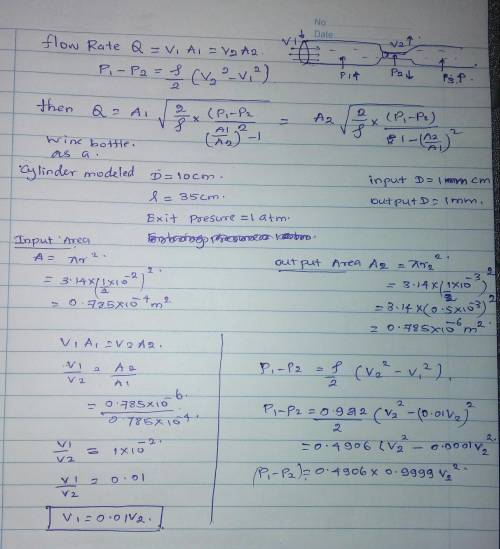
Engineering, 30.03.2020 19:13 ella8586
A wine aerator is a small, in-bottle, hand-held pour-through or decantor top device using the venturi effect for aerating the wine. These devices mix air into the wine as it flows through (or over), increasing exposure to oxygen and causing aeration. Apparently, wine which has been aerated tastes better. You want to design a new aerator that will also chill the wine as it is poured. This aerator will be aventuri-shaped tube with an input diameter of 1 cm and an output diameter of 1 mm. Determine the flow rate of the wine exiting theventure tube while pouring as a function of pouring angle and volume of wine in the bottle. The wine bottle can be modeled as a cylinder of 10 cm in diameter and length of 35 cm. You can assume the pressure at the exit is 1 atm and you can assume the head in the bottle while pouring has a pressure of 1 atm. You will need to determine the pressure at the inlet of the aerator as a function of time at various angles. Assume the bottle starts full. Also, calculate the resultant force needed to keep the device attached to the top of your wine bottle as a function of time for the same angles. Comment on maximum forces. Finally, you need to determine the rate that energy needs to be removed to chill the wine from room temperature to 4 C as it flows through the aerator.

Answers: 2


Another question on Engineering

Engineering, 04.07.2019 18:10
Asingle-geared blanking press has a stroke of 200 mm and a rated capacity of 320 kn. a cam driven ram is assumed to be capable of delivering the full press load at constant force during the last 15 percent of a constant-velocity stroke. the camshaft has an average speed of 90 rev/min and is geared to the flywheel shaft at a 6: 1 ratio. the total work done is to include an allowance of 16 percent for friction a) estimate the maximum energy fluctuation b) find the rim weight for an effective diameter of 1.2 m and a coefficient of speed fluctuation of 0.10
Answers: 1

Engineering, 04.07.2019 18:20
Avolume of 2.65 m3 of air in a rigid, insulated container fitted with a paddle wheel is initially at 264 k, 5.6 bar. the air receives 432 kj by work from the paddle wheel. assuming the ideal gas model with cv = 0.71 kj/kg • k, determine for the air the amount of entropy produced, in kj/k
Answers: 2

Engineering, 04.07.2019 19:10
Which of the following is the most important advantage of a large field of view? a. allows larger areas to be examined b. relieves eyestrain c. minimizes parallax errors. d. increases precision in proportion to the in- crease in field of view
Answers: 2

Engineering, 04.07.2019 19:10
Arigid tank contains 10 kg of air at 137 kpa (abs) and 21°c. more air is added to the tank until the pressure and temperature rise to 242 kpa (abs) and 32°c, respectively. determine the amount of air added to the tank. [r-0.287 kj/kg k]
Answers: 3
You know the right answer?
A wine aerator is a small, in-bottle, hand-held pour-through or decantor top device using the ventur...
Questions

Mathematics, 08.03.2021 17:30

Mathematics, 08.03.2021 17:30

Computers and Technology, 08.03.2021 17:30

Arts, 08.03.2021 17:30

Geography, 08.03.2021 17:30


Physics, 08.03.2021 17:30







Mathematics, 08.03.2021 17:30


History, 08.03.2021 17:30


Mathematics, 08.03.2021 17:30





